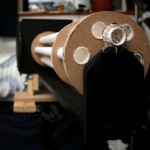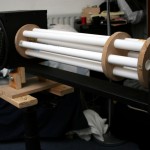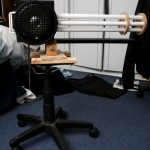I’m a proud a owner of a Frontier Stove, one of the things I really like about it is that is folds down so small and so takes up hardly room in the car. However this compactness also acts as one of its biggest downfalls, namely the diameter of the flue.
Since the flue is so small it is prone to clogging up with soot and also until the stove gets hot enough, it tends to not draw properly causing smoke to flow out out of the door. The latter is very annoying when the stove is installed in a tent.
The tent kit that you can buy from the Frontier Stove manufacturer is a silicon gasket which you bolt onto the tent. I didn’t particularly want to buy the kit or cut a hole in the tent and instead came up with a solution that protects the tent from heat damage, as well as improving the draw of the stove.
The draw of a flue is determined by the volume of air in the flue and the average temperature difference between the hot gasses and the ambient air outside outside of the flue. Since the Frontier Stove flue is long and thin it tends to cool the hot gasses which reduces the flow. I had previously tried extending the flue (to increase volume), but found that the hot gases were being cooled too much, so that unless the stove was burning really hot it would hardly draw at all. The cooler flue also increases the amount of soot and tar which stick to the sides of the flue and eventually clog it up.
The solution was to insulate the flue. I found on ebay some rockwool pipe lagging that is covered in foil, which has a dramatic insulating effect compared to the bare pipe, it also allows the flue to pass through the tent without causing heat damage. Below is a picture from a recent camp showing it in action.
Even though the insulation only covers just under half of the flue, it has made a big improvement to the draw of the stove. I’m intending on buying another section of insulation to cover the rest of the flue in the near future.







